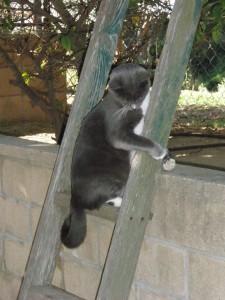 There are some things that experts say you should never do with, to, or around your cat and most of us have probably done them. For example, it’s thought that the shushing sound you make when trying to calm a nervous cat might actually make her more tense. It never occurred to me, but while we consider the “shhhhh” sound to be comforting, to your cat, some experts say it might sound like you’re hissing at her. Hissing, in cat language, is threatening not soothing.
There are some things that experts say you should never do with, to, or around your cat and most of us have probably done them. For example, it’s thought that the shushing sound you make when trying to calm a nervous cat might actually make her more tense. It never occurred to me, but while we consider the “shhhhh” sound to be comforting, to your cat, some experts say it might sound like you’re hissing at her. Hissing, in cat language, is threatening not soothing.
Speaking of threatening, what about the stare? Some say you should not stare into a cat’s eyes. Why is that? Some cats are rather aggressive and will respond to a challenge. Yes, a stare can be considered a challenge. If you’ve ever watched two cats challenge each other, you’ll see them stare at each other until one drops his eyes and turns away or one of them attacks. Most docile domestic cats will stare into their beloved person’s eyes—sometimes for long periods. Maybe the cat’s waiting for that slow blink of affection. If you’re fortunate, she’ll return the blink. It’s oh, such a beautiful moment.
say you should not stare into a cat’s eyes. Why is that? Some cats are rather aggressive and will respond to a challenge. Yes, a stare can be considered a challenge. If you’ve ever watched two cats challenge each other, you’ll see them stare at each other until one drops his eyes and turns away or one of them attacks. Most docile domestic cats will stare into their beloved person’s eyes—sometimes for long periods. Maybe the cat’s waiting for that slow blink of affection. If you’re fortunate, she’ll return the blink. It’s oh, such a beautiful moment.
 Never push a cat off a counter of other high perch (where she’s not supposed to be, for example). It won’t teach her anything and it could, in fact, harm her. People who depend on a cat always falling on their feet and who try to test this “fact” are asking for trouble (for the poor cat). Sure a cat, when jumping or even falling, can twist into position and most often land on his feet. But he can also end up injured. If you push a cat from a countertop, for example, he may not have time to rebound. Instead, encourage the cat to jump down or better yet, lift him down. If you want to keep your cat off the counter, good luck with that. One idea might be to bring in or build a great cat tree—you know, a climbing apparatus to keep your cat happy, entertained, and healthy. Tin foil can also be a determent for a cat who wants to be on the counter or claw the furniture.
Never push a cat off a counter of other high perch (where she’s not supposed to be, for example). It won’t teach her anything and it could, in fact, harm her. People who depend on a cat always falling on their feet and who try to test this “fact” are asking for trouble (for the poor cat). Sure a cat, when jumping or even falling, can twist into position and most often land on his feet. But he can also end up injured. If you push a cat from a countertop, for example, he may not have time to rebound. Instead, encourage the cat to jump down or better yet, lift him down. If you want to keep your cat off the counter, good luck with that. One idea might be to bring in or build a great cat tree—you know, a climbing apparatus to keep your cat happy, entertained, and healthy. Tin foil can also be a determent for a cat who wants to be on the counter or claw the furniture.
What about the laser pointer? Sure it’s fun to watch a cat dart around the room after the little red dot. But think about it, is it really fun for her? What are we taught about cats early on during our relationship with them and by studying cat behavior? They love to chase, but, in order to keep them interested in chasing a feather on the end of a wand, for example, they must be allowed to catch it sometimes. There’s no way they can gain this level of satisfaction when chasing a laser pointer. Those things are for the amusement of people, not cats. Sure, you can offer a little exercise opportunity with a laser pointer if you want—but don’t torture and frustrate your cat by playing endlessly with that thing.
Don’t over-pet your cat. Is that possible? For some cats, yes. Sure, some cats love any and  all petting they can get from anyone and everyone. Other cats have their limits. Sophie pretty much comes under the first scenario—she’ll accept petting anytime it’s offered and asks for it frequently—well, except from strangers. Lily loves being with us and sometimes she adores being petted. But she restricts us from enjoying sweet petting sessions with her. Sometimes she dips her back to avoid being petted. She’ll roll over and give you a play-bite when the petting or brushing has become too vigorous. I think she easily becomes over-stimulated and she’s not shy about letting us know. Some cats can become quite aggressive when they’ve had enough. While most will walk away at that point, others will bite and claw aggressively.
all petting they can get from anyone and everyone. Other cats have their limits. Sophie pretty much comes under the first scenario—she’ll accept petting anytime it’s offered and asks for it frequently—well, except from strangers. Lily loves being with us and sometimes she adores being petted. But she restricts us from enjoying sweet petting sessions with her. Sometimes she dips her back to avoid being petted. She’ll roll over and give you a play-bite when the petting or brushing has become too vigorous. I think she easily becomes over-stimulated and she’s not shy about letting us know. Some cats can become quite aggressive when they’ve had enough. While most will walk away at that point, others will bite and claw aggressively.
We take in cats as pets—care for them, buy them things, adjust our lives around their comfort and safety, isn’t that enough? No. It’s also important to understand and respect a cat, especially your particular cat.





